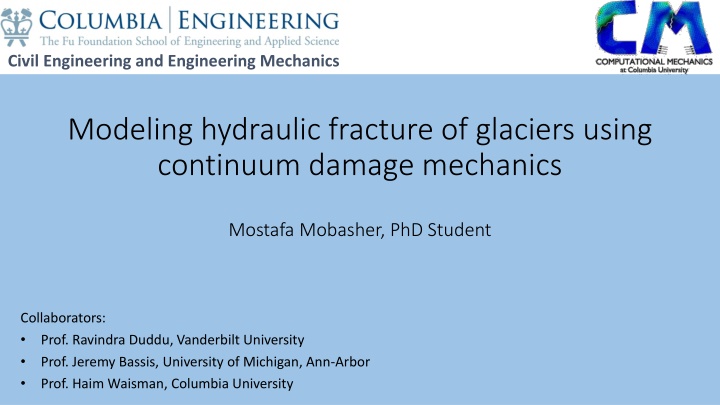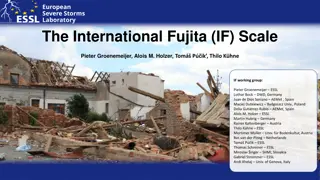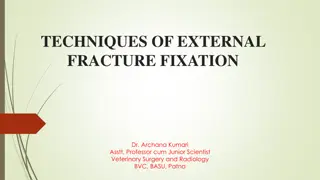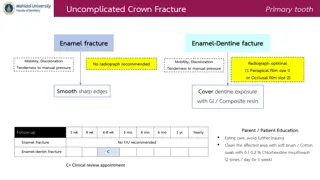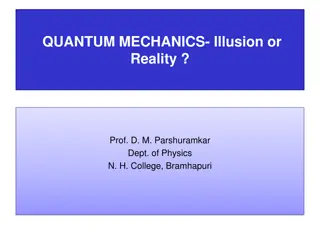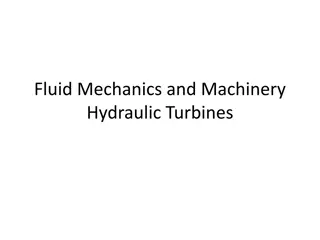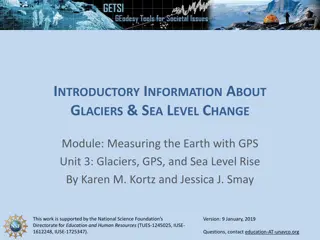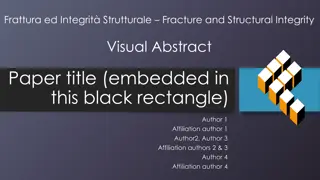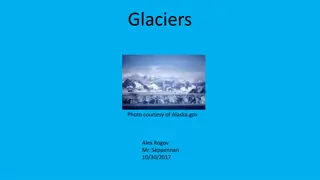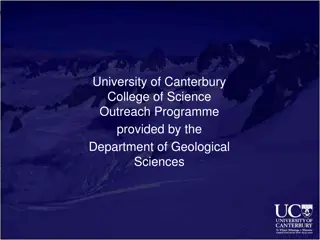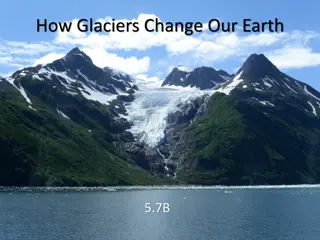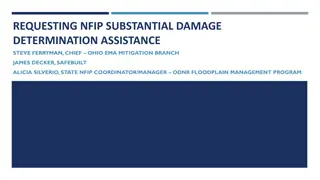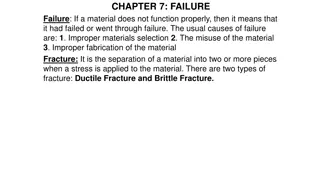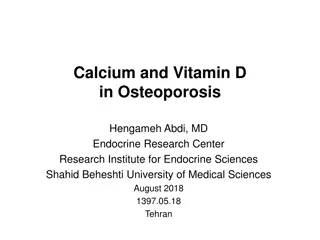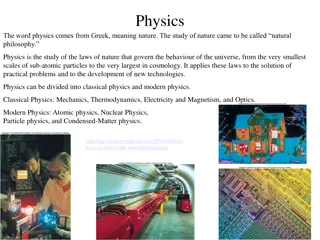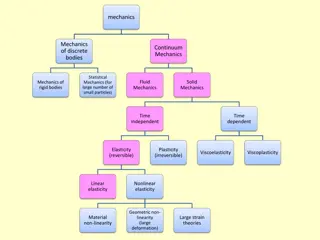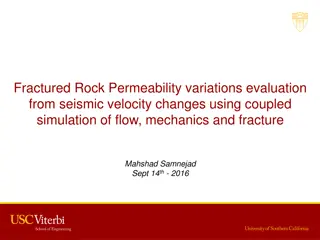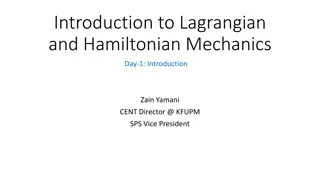Modeling Hydraulic Fracture of Glaciers Using Continuum Damage Mechanics
Civil Engineering and Engineering Mechanics study hydraulic fracture of glaciers with a focus on continuum damage mechanics. The project involves a viscoelastic ice model and explores the effects of surface and basal crevasses on glacier calving. The research incorporates empirical models, linear elastic fracture mechanics, and continuum damage mechanics to understand the complex behavior of ice under varying conditions. Collaborators include Prof. Ravindra Duddu, Prof. Jeremy Bassis, and Prof. Haim Waisman.
Download Presentation

Please find below an Image/Link to download the presentation.
The content on the website is provided AS IS for your information and personal use only. It may not be sold, licensed, or shared on other websites without obtaining consent from the author.If you encounter any issues during the download, it is possible that the publisher has removed the file from their server.
You are allowed to download the files provided on this website for personal or commercial use, subject to the condition that they are used lawfully. All files are the property of their respective owners.
The content on the website is provided AS IS for your information and personal use only. It may not be sold, licensed, or shared on other websites without obtaining consent from the author.
E N D
Presentation Transcript
Civil Engineering and Engineering Mechanics Modeling hydraulic fracture of glaciers using continuum damage mechanics Mostafa Mobasher, PhD Student Collaborators: Prof. Ravindra Duddu, Vanderbilt University Prof. Jeremy Bassis, University of Michigan, Ann-Arbor Prof. Haim Waisman, Columbia University
Introduction Damage Model Of Hydraulic Fracture Of Ice Calving ice is responsible for 50 % of the total ice mass loss. Introduction Mechanical model: Viscoelastic ice Damage Hydro-visco damage FEM: Idealized model Time scaling Effect of surface crevasse Effect of basal crevasse Mutual effect of water filled crevasses Summary and future work 2
Introduction Literature review Empirical models e.g. height-above-buoyancy and water-depth: Limited applicability to specific cases Ignore physical factors e.g. strain rate and hydro-fracture Damage Model Of Hydraulic Fracture Of Ice Introduction Mechanical model: Viscoelastic ice Damage Hydro-visco damage Linear Elastic Fracture Mechanics: Difficulty of incorporating non-linear material behavior, ice is usually described as a viscous fluid of a viscoelastic solid FEM: Idealized model Time scaling Effect of surface crevasse Effect of basal crevasse Mutual effect of water filled crevasses Continuum Damage Mechanics, viscoelastic damage models: Difficulty of incorporating hydro-damage crack surface is not explicitly defined. Computational difficulty: Multiple length scales Multiple temporal scales Summary and future work 3
Mechanical Model Viscoelastic model of Ice Assuming small elastic strain: ?+ ??? Damage Model Of Hydraulic Fracture Of Ice ? ???= ??? Introduction ? is elastic strain and ??? ? is viscous strain Mechanical model: Viscoelastic ice Damage Hydro-visco damage ??? is total strain, ??? Hooke s law: ? ???= ???????? FEM: Idealized model Time scaling Effect of surface crevasse Effect of basal crevasse Mutual effect of water filled crevasses ????? is the stiffness tensor and ??? is the Cauchy stress tensor Evolution of viscous strain ? 1???dev ?= ??? ??? ?, ? are temperature dependent constants, ?? is Von-Mises stress and ???dev is the deviatoric stress Summary and future work 4
Mechanical Model Viscoelastic damage Damage Model Of Hydraulic Fracture Of Ice Equivalent state Aeff=(1-D)?0 Virgin state Area=?0 Cracks & pores Introduction Loading Damage = ? Mechanical model: Viscoelastic ice Damage Hydro-visco damage Effective stress concept: FEM: Idealized model Time scaling Effect of surface crevasse Effect of basal crevasse Mutual effect of water filled crevasses ??? ???= 1 ? ? is the damage variable Magnified viscous strain: Summary and future work ? ? 1 ???dev= ? 1???dev ?= ? ?? ??? 1 ???? 5
Mechanical Model Hydraulic effects on damage Stress state ???= (1 ?) ??? ?? ??? Damage Model Of Hydraulic Fracture Of Ice Introduction Hydrostatic pressure Mechanical model: Viscoelastic ice Damage Hydro-visco damage ? = ??? ? Assumption: pressure remains hydrostatic, fluid fills all pores instantly This formulation can be mapped to poroelasticity, however, this assumption leads to a system of equations that is function of solid displacements only. Hence, reduced computational effort. FEM: Idealized model Time scaling Effect of surface crevasse Effect of basal crevasse Mutual effect of water filled crevasses Final Hooke s law form: ? ??? ? ???? ???= (1 ?)???????? ? ??=??? ? ? ??? Summary and future work = 1 ?)?????? ? ???????? ???????? ? 6
Mechanical Model Hydro-viscoelastic damage Damage evolution law Pralong and Funk (2005): Damage Model Of Hydraulic Fracture Of Ice ? ?? 1 ??? ? = ? ?1+ ? ?? (1 ? ?) ???, ?1> 0 ?1 0 if Introduction ? = Mechanical model: Viscoelastic ice Damage Hydro-visco damage 0, if ? is the time scale constant, ?? ,?,? and ? are constants and ?1 is the largest eigenvalue of effective stress Boundary value problem FEM: Idealized model Validation-LEFM Time scaling Effect of surface crevasse Effect of basal crevasse ???,?+ ??= 0in ? =1 ? ?in ? ??? 2(??,?+ ??,?) ??? ???= ????? ???? ?in ? Summary and future work ??= ??in ?? ?????= ?? in ?? 7
FEM Idealized model Idealized grounded rectangular slab Damage Model Of Hydraulic Fracture Of Ice Introduction Mechanical model: Viscoelastic ice Damage Hydro-visco damage FEM: Idealized model Time scaling Effect of surface crevasse Effect of basal crevasse Mutual effect of water filled crevasses Summary and future work 8
FEM Time scaling parametric study Damage evolution law: Damage Model Of Hydraulic Fracture Of Ice ? ?? 1 ??? ? = Introduction Time scale parameter: B Surface crevasse propagation: Wet (solid line) Dry (dotted line) Mechanical model: Viscoelastic ice Damage Hydro-visco damage FEM: Idealized model Time scaling Effect of surface crevasse Effect of basal crevasse Mutual effect of water filled crevasses Summary and future work Variation of B leads to stretching in time scale, minor effect on final crevasse depth. 9
FEM Effect of water in surface crevasses Dry surface crevasses Wet basal crevasses Higher hw leads to higher pressure in basal crevasse As hw increases, stress at surface crevasses decreases and stress at basal crevasses increases Damage Model Of Hydraulic Fracture Of Ice Introduction Mechanical model: Viscoelastic ice Damage Hydro-visco damage FEM: Idealized model Time scaling Effect of surface crevasse Effect of basal crevasse Mutual effect of water filled crevasses Summary and future work Final crevasse depth vs. hw/H Crevasse evolution time vs. hw/H 10
FEM Effect of water in surface and basal crevasses Wet surface crevasses Wet basal crevasses As hw increases, stress at surface crevasses decreases and stress at basal crevasses increases In the case of wet surface crevasse, mutual effect of hydraulic cracks lead to higher calving possibilities Damage Model Of Hydraulic Fracture Of Ice Introduction Mechanical model: Viscoelastic ice Damage Hydro-visco damage FEM: Idealized model Time scaling Effect of surface crevasse Effect of basal crevasse Mutual effect of water filled crevasses Summary and future work Crevasse evolution time vs. hw/H Final crevasse depth vs. hw/H 11
FEM Mutual effect of propagating crevasses Damage Model Of Hydraulic Fracture Of Ice Introduction Mechanical model: Viscoelastic ice Damage Hydro-visco damage FEM: Idealized model Time scaling Effect of surface crevasse Effect of basal crevasse Mutual effect of water filled crevasses Summary and future work Final crevasse depth vs. hw/H Final crevasse depth vs. hw/H 12
FEM Analysis of evolution of basal crevasses Under low piezometric pressure in the basal crevasse, the basal crevasse remains idle until the wet surface crevasse gets close to the basal crevasse. hw /H=0.25 Damage Model Of Hydraulic Fracture Of Ice Introduction Mechanical model: Viscoelastic ice Damage Hydro-visco damage FEM: Idealized model Time scaling Effect of surface crevasse Effect of basal crevasse Mutual effect of water filled crevasses Summary and future work 13
Summary and future work Summary: Half of ice mass is lost in calved ice Hydro-visco-damage mechanics model is proposed for hydro-fracture of ice Thorough analysis of surface and basal crevasses under different conditions Mutual effect of water-filled crevasses Future work: Floating ice shelves Large deformations Multiple crevasses Variable permeability analysis of flow behavior Freezing and crack closure Acknowledgment: Funding support provided by the National Science Foundation, Polar Programs division, Grant # PLR 1341472, PLR 1341568 and PLR-1341428. Damage Model Of Hydraulic Fracture Of Ice Introduction Mechanical model: Viscoelastic ice Damage Hydro-visco damage FEM: Idealized model Time scaling Effect of surface crevasse Effect of basal crevasse Mutual effect of water filled crevasses Summary and future work 14
